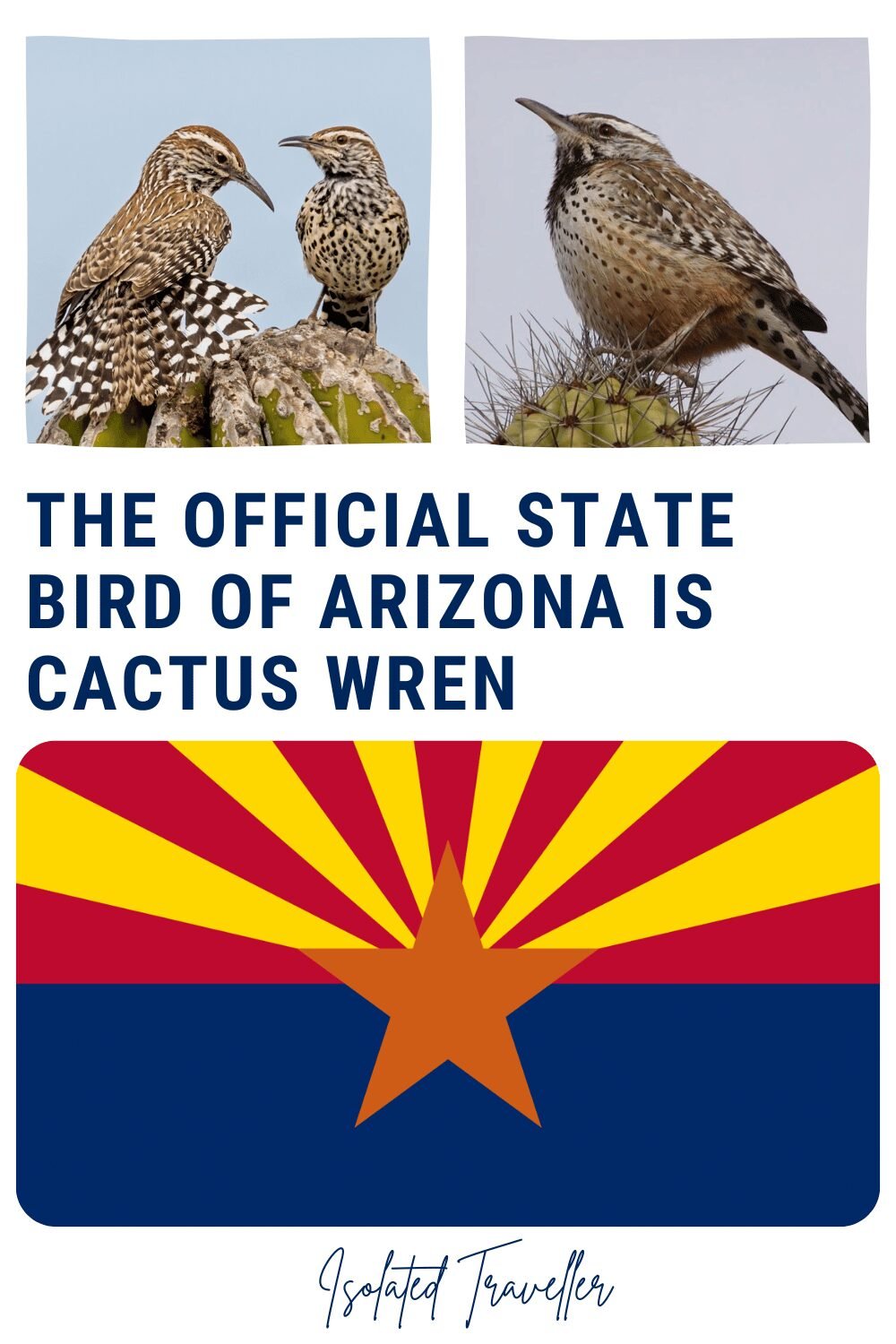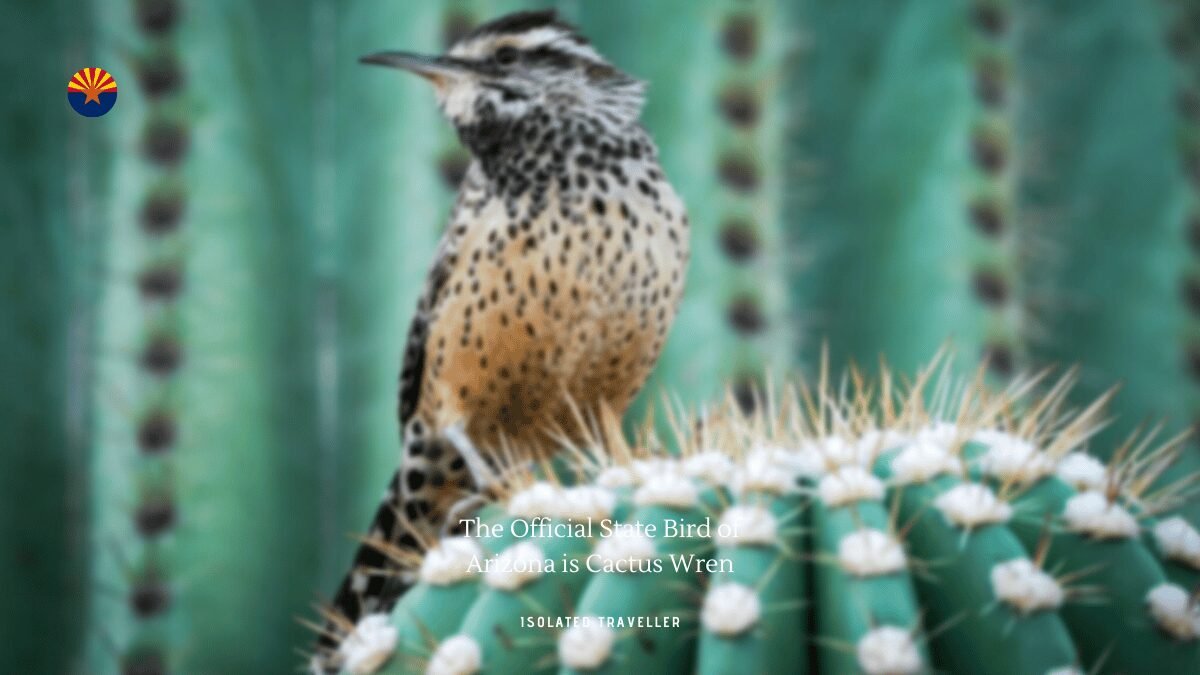The Official State Bird of Arizona is Cactus Wren
In 1931, the Arizona state legislature officially adopted the cactus wren is the official state bird. This little brown and white bird is a common sight in the Sonoran Desert, where it builds its nests in cacti and other thorny plants. While their numbers have declined in recent years, cactus wrens are still considered by many to be Arizona’s unofficial symbol.
The cactus wren is a plump, noisy bird, that can be found in the dry deserts of Arizona and southwards into northern Mexico. The cactus wren is the largest wren in North America with an average length of about 13–14 cm (5.1–5.5 in) and a wingspan of 21 cm (8.3 in). The cactus wren was named Arizona’s state bird on April 2, 1973.
Arizona’s State Bird
The cactus wren is the official state bird of Arizona. It was officially adopted by the Arizona state legislature in 1931. The cactus wren is a common sight in the Sonoran Desert, where it builds its nests in cacti and other thorny plants. While their numbers have declined in recent years, cactus wrens are still considered by many to be Arizona’s unofficial symbol.
Identifying Features
The cactus wren is Arizona’s largest wren, measuring about eight inches long from beak to tail. Its back and wings are brown, its belly is white, and its tail is long and black with white stripes. Its beak is slightly curved. Cactus wrens have a distinctive call that sounds like they’re saying “teakettle teakettle teakettle.”
Range and Habitat
Cactus wrens are found in the southwestern United States and Mexico. In Arizona, they live in the Sonoran Desert, which covers much of southern Arizona. Cactus wrens prefer open desert habitats with lots of cacti, but they can also be found in scrubland, woodlands, and even urban areas.
Nesting Habits
Cactus wrens build their nests in cacti and other thorny plants. The female builds the nest out of twigs, leaves, grass, feathers, and other materials. She usually lays three to seven eggs in a nest, which hatch after about two weeks. Both parents help care for the young birds.
Wild Status
While cactus wrens are not considered endangered, their numbers have declined in recent years. This is likely due to habitat loss and fragmentation as the Sonoran Desert has been developed for agriculture and urbanization.
Vocalizations
Their song is a series of high-pitched trills, chirps and whistles that last about 3 seconds on average. The song is given from a perch or from the ground, but not in flight. In general, Cactus Wrens give their song more frequently during the breeding season than at other times of year; however they may sing throughout the year if they have an established territory.
The cactus wren has a distinctive call that sounds like they’re saying “teakettle teakettle teakettle.” They also make a variety of other vocalizations, including chirps, clicks, and trills.
Behaviour and ecology
Cactus wrens are highly territorial, and will often chase other birds away from their territory. They forage for food on the ground, eating insects, lizards, and other small animals. Cactus wrens mate for life and usually have two to three broods of young per year.
Cactus Wrens are active during the day and at night. They are found in desert scrub and desert grassland habitats within their range. Cactus Wrens are found in the Sonoran Desert, which covers a large portion of Arizona as well as parts of California, Utah, Nevada and New Mexico; the Chihuahuan Desert (also known as the Basin and Range Province) which covers southeastern Arizona; and several other scattered locations across western North America from southern British Columbia through northern Mexico.
Breeding and nestin
Cactus Wrens are fairly monogamous, so they pair with the same mate each breeding season. The male usually arrives first and selects a nest site that is high in a tree or cactus. This allows him to have an unobstructed view of predators and intruders while he watches over his family.
The female builds the nest out of plant fibres, grasses, roots and other materials she finds in her environment. She lines it with feathers or fur from dead animals that might be nearby. The female lays four to seven eggs at a time; these eggs are pale blue with brown speckles on them (just like their parents!).
After about two weeks of incubation by both parents, young Cactus Wrens break through their shells and emerge into the world! They grow quickly during this time but eventually fly away from their nests after about 28 days of life outside of them (or about two months total).
If you’re lucky enough to spot a cactus wren in the wild, you’ll be seeing one of Arizona’s most iconic animals. These little birds are an important part of the state’s ecosystem.
If you’re ever in Arizona during the summer months, keep your eyes peeled for the cactus wren! These little birds are most active during the cooler hours of the day, so they’re often
Scientific Classification
| Type | Information |
| Kingdom | Animalia |
| Phylum | Chordata (chordates) |
| Class | Aves (birds) |
| Order | Passeriformes (perching birds) |
| Family | Troglodytidae (wrens) |
| Genus | Campylorhynchus |
| Species | C. brunneicapillus (brown-capped curved bill) |
| Scientific Name | Campylorhynchus brunneicapillus, 1835 |
| Taxonomic Serial Number | 178587 |








